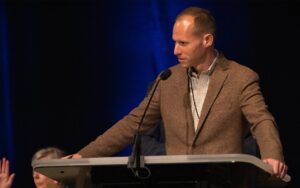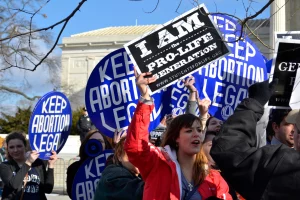
NASHVILLE (BP) — When First Baptist Church in Bettendorf, Iowa, needed to decrease its Cooperative Program (CP) giving in a financial pinch this year, the congregation consented on one condition: that they could increase it as soon as possible back to its previous level of 16.5 percent of undesignated receipts. Leaders agreed, and First Baptist approved temporary CP giving of 10 percent.
“During our congregational meeting, people were saying, ‘Wait a second. We can’t continue to let this happen. This has to be more than 10 percent,’” said pastor Cory Gonyo, a current International Mission Board trustee and former IMB missionary to Southeast Asia. “It was a pleasant surprise.”
At 10 percent, First Baptist still is among the top CP-giving churches in the Baptist Convention of Iowa and well above the SBC average of 4.59 percent. From where does such passion for CP arise? Ironically, Gonyo said, not from talking about CP.
“The concept of Cooperative Program is less about the title ‘Cooperative Program’ and more about the Great Commission,” he said. “It’s about understanding the need among the nations for those who have never heard of Jesus Christ.”
First Baptist seems representative of many strong CP-giving churches. For the Cooperative Program to thrive among rising generations, pastors say, churches must emphasize reaching the lost and making disciples more than a system of missions support.
“Sacrificially generous”
It hasn’t always been that way. In the mid-20th century the SBC adopted a “program-oriented approach to ministry,” sometimes without adequate theological underpinnings, according to an analysis by Southwestern Baptist Theological Seminary President David Dockery. During the era of programs, CP was on the rise.
In recent decades, a shift away from loyalty to institutions and programs has corresponded with a slip in CP. The SBC’s share of CP receipts eclipsed $195 million in 2022, its highest level since 1999. But that increase came because Baptist state conventions forwarded increasing percentages of their CP receipts to SBC causes. Total CP giving from churches to their state conventions has declined steadily since 2008. Churches gave just over $457 million through CP in 2022, a 16 percent decline from 2008. That translates to nearly $84.5 million less for Southern Baptist missions and ministries.
So, can a beloved program like CP thrive in a denominational culture moving away from programs? Yes, says Chris James. It’s just going take a change in the way CP is promoted. The church James pastors is proving the new approach can work. Mill City Church in Lowell, Mass., averages approximately 200 in worship and gives about 8 percent of its undesignated receipts through CP, making it one of the top CP givers in the Baptist Convention of New England.
The giving “doesn’t have to do with CP,” James said, as much as “teaching our people to be generous and to be sacrificially generous.”
Mill City divides its missions giving between CP and what it calls “Mill City Missions”—direct mission work in conjunction with a variety of Southern Baptist and non-Southern Baptist organizations. James, a former North American Mission Board collegiate missionary, says the church’s giving through CP increases as its hands-on missions involvement through other channels also increases.
“We have been a strong supporter of CP,” James said, “but we’ve also done a lot of other things too. I don’t think that by investing in other places we have hindered CP. Every single time we’ve increased our giving on one side, we have increased it on the other side.”
The “tradition factor”
Of course, programs and traditions still have their place. First Baptist Church in Montgomery, Ala., says its long tradition of CP giving helps fuel its passion for missions. The church gives 11 percent of undesignated receipts through CP—nearly three-quarters of a million dollars in 2023, according to data from the SBC’s Annual Church Profile.
Several leaders of the Alabama Baptist State Board of Missions, including executive director Rick Lance, attend First Baptist. They share regularly about the difference Southern Baptist ministries are making. That “certainly helps,” pastor Mark Bethea said, noting a “deep-seated love for missions” among the congregation.
“I definitely think there is a tradition factor of being proud of our Cooperative Program giving,” Bethea said, “because we believe the Cooperative Program has been used wisely in missions funding and seminary education funding.”
Something similar has occurred at Mexico Baptist Church in Marion, Ky., which gives 25 percent of its undesignated receipts through CP. Pastor Tim Burton says that giving stems from passion to reach the lost and a tradition of missions giving. The congregation has missions groups for all ages and devotes one Wednesday night a month exclusively to missions education.
Burton urges all churches to strive toward increasing CP.
“If all of those churches that are giving 3 or 4 percent—if they looked at their budgets and structured themselves where they were all giving 20-25 percent,” he said, “it would be astronomical … Just think about the impact of that.”
“The mission of God”
In some settings, calls focused on increasing CP percentages aren’t the most effective way to bolster the Cooperative Program, according to Chris Morgan, pastor of Immanuel Baptist Church in Highland, Calif., and a dean at California Baptist University. The church gives $330,000 of its $4.7 million budget through CP, but Morgan is uninterested in what percentage that represents (7 percent). Neither he nor the church focuses on CP percentages, but on giving as many dollars as they can to make disciples of all nations alongside trusted friends.
Leaders from Cal Baptist, the IMB, NAMB, Gateway Seminary, the California Southern Baptist Convention and Immanuel’s local association have preached at the church. The congregation trusts them, Morgan said, and wants to partner in ministry with people like that. In addition to its CP giving, Immanuel gives another $100,000 annually to SBC ministries.
We cannot “just talk about CP” and expect people to give, Morgan said. Church members “are going to give because they believe in the Kingdom of God. They’re going to give because we are united in Christ together and we participate together in the mission of God. They’re going to give because they believe in the Great Commission.”
“Once they understand [CP] is a great system by which the mission of God is accomplished,” he said, “then they’re going to give.”
That may work at Immanuel, but will CP giving rebound Convention-wide with renewed emphasis on the mission of God? That has yet to be seen. One thing is sure though: CP giving seems on track to rebound under such an emphasis at First Baptist, Bettendorf. The finance committee has been reporting to the congregation regularly, and everyone hopes to give more than 10 percent by early next year.
“When people see that giving to the Cooperative Program means taking the Gospel to those who have never heard before,” Gonyo said, “then it lines up with their heart, their conviction and their passion for the Great Commission.”
















